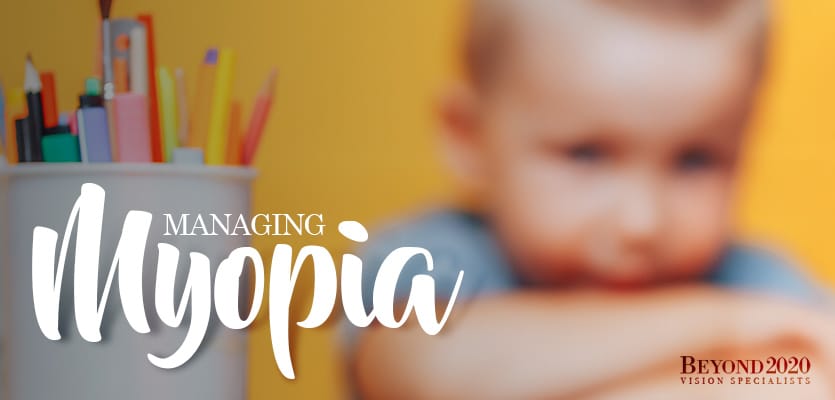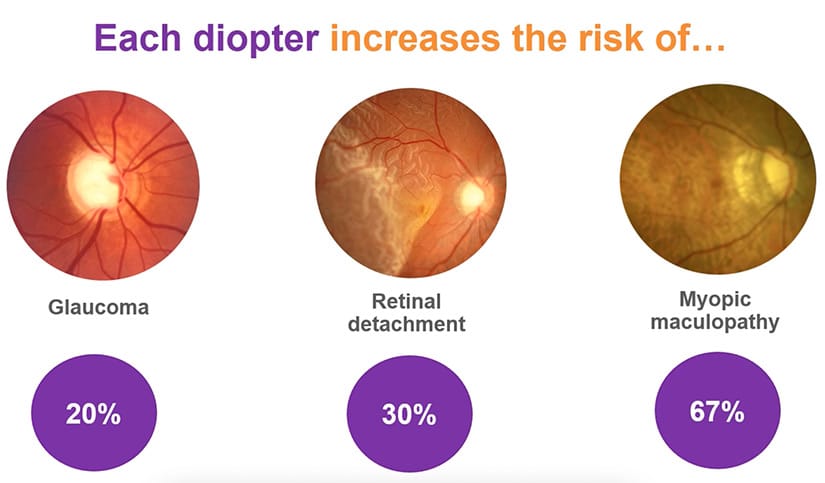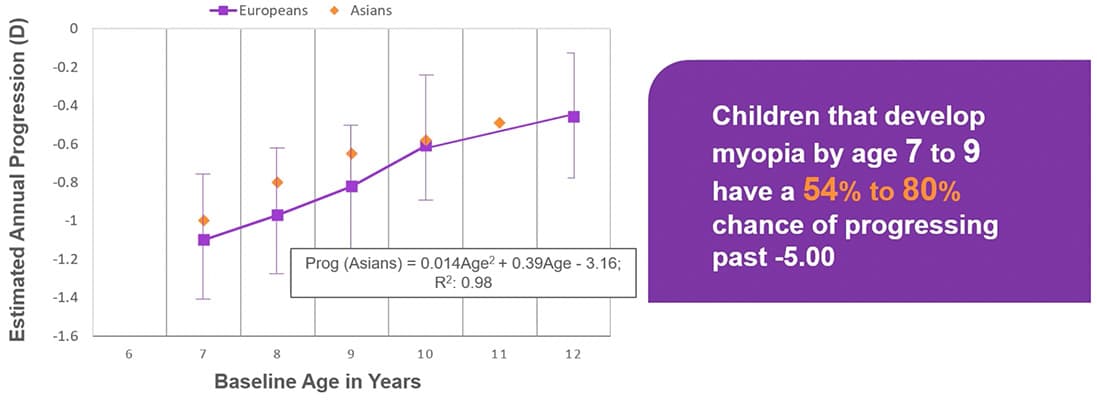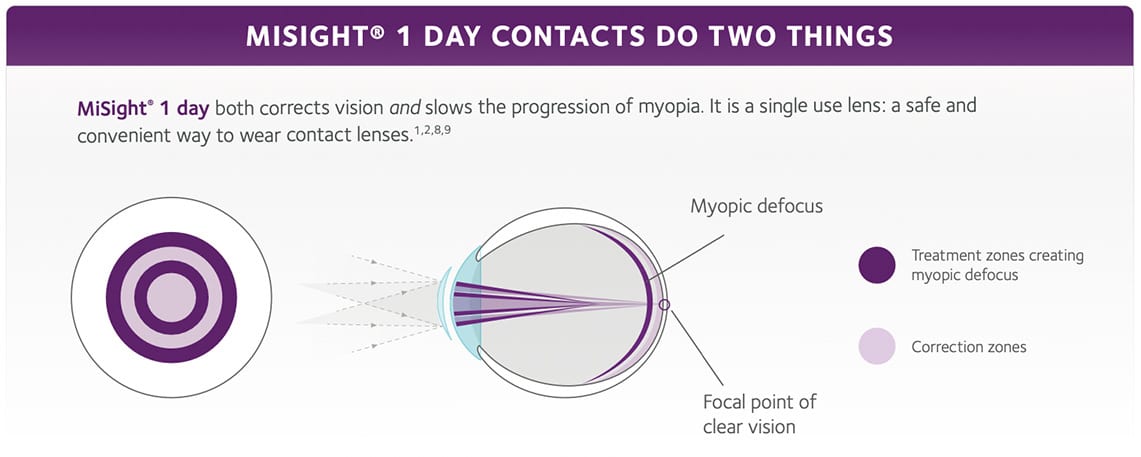Myopia Management for Children
Home » Myopia Management for Children

What is Myopia?
Myopia, also known as nearsightedness, is a refractive error of the eye that occurs when the eye is too long or the cornea (the clear front part of the eye) is too curved, causing light rays to focus incorrectly on the retina (the light-sensitive layer at the back of the eye). As a result, objects that are far away appear blurry, while objects that are closer appear clearer. Myopia is a common condition that affects millions of people around the world. It usually develops in childhood and can progress until about age 20. It can be corrected with glasses, contact lenses, or refractive surgery. Access to treatment at the earliest opportunity may help prevent the onset of cataracts, glaucoma, or detached retinas later in life.
Causes of Myopia in Children
- Genetics: Myopia tends to run in families, so children who have a family history of myopia are more likely to develop the condition.
- Environmental factors: Children who spend a lot of time doing close work, such as reading or using a computer, may be at higher risk of developing myopia.
- Lifestyle factors: Children who spend less time outdoors and more time indoors may be at higher risk of developing myopia.
- Eye development: Myopia can occur if the eye grows too long or the cornea becomes too curved during the developmental years.
It’s worth noting that the exact cause of myopia is not fully understood, and it is likely that a combination of genetic and environmental factors contribute to the development of the condition.
How to Slow the Progression of Myopia in Children
There are several ways to slow the progression of myopia in children:
- Encourage outdoor activities: Spending time outdoors may help to slow the progression of myopia. This is thought to be due to the increased exposure to natural light and the ability to focus on distant objects.
- The use of MiSight soft contact lenses can help to correct myopia and slow its progression.
- Orthokeratology: This is a non-surgical treatment that involves wearing special contact lenses overnight to gently reshape the cornea. This can reduce the need for glasses or contact lenses during the day.
- Atropine eye drops: These drops can be used to dilate the pupils and reduce the amount of near work required. This may help to slow the progression of myopia.
It’s important to note that the effectiveness of these methods can vary and it’s best to discuss the best options with an eye care professional.
MiSight 1 Day Contact Lenses
MiSight 1 Day contact lenses are soft contact lenses designed to correct myopia (nearsightedness) in children. These lenses are intended to slow the progression of myopia in children who are at risk of developing the condition or who have already been diagnosed with myopia. MiSight 1 Day contact lenses are daily disposable lenses, which means they are worn for one day and then discarded. This helps to reduce the risk of eye infections and other complications associated with contact lens wear.
MiSight 1 Day contact lenses work by incorporating two prescriptions in the same lens. The center of the lens is designed to correct nearsightedness, while the outer part of the lens helps to focus light on the periphery of the retina, which may help to slow the progression of myopia. These lenses are made from a soft, flexible material that is comfortable to wear and easy to handle.
Alternative treatments for myopia in children may deserve consideration as well. The extent of the condition varies for each child, and optometrist Dr. Christopher Tumolo can advise parents on the best approach to slowing progression.
What is Orthokeratology?
Orthokeratology, also known as corneal reshaping therapy or ortho-k, is a non-surgical treatment that involves wearing special contact lenses overnight to gently reshape the cornea (the clear front part of the eye). The goal of ortho-k is to correct vision problems such as myopia (nearsightedness), hyperopia (farsightedness), and astigmatism (irregular curvature of the cornea).
Ortho-k lenses are made from a rigid, gas-permeable material that is designed to reshape the cornea while you sleep. The lenses are removed in the morning, and vision is typically improved for the rest of the day without the need for glasses or daytime contact lenses. Ortho-k can be an effective treatment option for people who want to reduce their dependence on glasses or contact lenses, or who are not suitable candidates for laser eye surgery.
What are Atropine Drops?
Atropine eye drops are a type of medication that is used to dilate (enlarge) the pupils and reduce the amount of near work required. Atropine eye drops are sometimes used to treat a condition called accommodative esotropia, which is a type of crossed eyes (strabismus) that occurs when the eyes are not properly aligned. Atropine eye drops are also sometimes used to treat myopia (nearsightedness) in children in an attempt to slow the progression of the condition.
Atropine eye drops work by inhibiting the action of a chemical called acetylcholine, which is involved in the contraction of the ciliary muscle in the eye. By inhibiting the action of acetylcholine, atropine eye drops cause the pupil to dilate and the ciliary muscle to relax, which can reduce the amount of near work required. Atropine eye drops are usually administered once or twice a day and should be used as directed by an eye care professional.
Living with Myopia
- Wear glasses or contact lenses as prescribed: Wearing glasses or contact lenses can help to correct myopia and improve your vision. It’s important to wear these as prescribed by your eye care professional and to follow their instructions for use.
- Take breaks from close work: If you spend a lot of time doing close work, such as reading or using a computer, it’s important to take breaks to give your eyes a rest. Every 20-30 minutes, look away from the screen and focus on something in the distance for a few seconds.
- Practice good eye hygiene: If you wear contact lenses, it’s important to practice good eye hygiene to reduce the risk of eye infections and other complications. This includes washing your hands before handling the lenses, replacing the lenses as directed, and storing the lenses in the appropriate solution.
- Wear sunglasses: Myopia can increase your risk of developing cataracts (a clouding of the lens in the eye) and other eye conditions. Wearing sunglasses can help to protect your eyes from harmful UV rays and reduce the risk of these conditions.
- See your eye care professional regularly: Regular eye exams are important for maintaining good eye health and detecting any changes in your vision. It’s important to see your eye care professional as recommended for check-ups and follow their advice for managing your myopia.
Additional Information about Myopia
The retina is a thin layer of tissue at the back of the eye that contains specialized cells called photoreceptors, which are responsible for detecting light and converting it into neural signals that are sent to the brain for processing. There are two types of photoreceptors in the retina: rods and cones. Rods are responsible for vision in low light conditions, while cones are responsible for color vision and visual acuity in bright light conditions.
In addition to photoreceptors, the retina contains a complex network of other types of cells, including bipolar cells, ganglion cells, and interneurons, that work together to process visual information and send it to the brain.
One type of retinal cell that has been implicated in the regulation of eye growth and myopia is the dopaminergic amacrine cell. These cells are located in the inner nuclear layer of the retina, and they are specialized for the release of dopamine, a neurotransmitter that plays an important role in regulating eye growth and visual development.
Dopamine release from the dopaminergic amacrine cells is stimulated by certain wavelengths of light, including blue light. When the retina is exposed to bright outdoor light, which is rich in blue light, the dopaminergic cells are activated and release dopamine, which helps to regulate eye growth and prevent myopia.
The mechanism by which dopamine regulates eye growth is complex and not fully understood, but it is thought to involve the interaction between dopamine and other signaling pathways in the eye. One proposed model is that dopamine acts to inhibit the activity of certain types of retinal cells, such as the ON-type bipolar cells, which are known to promote eye growth and myopia development. By inhibiting these cells, dopamine can help to slow down the elongation of the eyeball and maintain proper focus on distant objects.
Conversely, when the eye is exposed to blurry or defocused images, there is a decrease in dopamine release from the dopaminergic amacrine cells, which can lead to excessive elongation of the eyeball and the development of myopia.
The relationship between blue light and myopia is complex and not fully understood, and there is ongoing research to determine the optimal levels of blue light exposure needed for good eye health. While exposure to bright outdoor light has been shown to have a protective effect against myopia, excessive exposure to blue light from digital screens and other artificial sources may also have negative effects on eye health, such as causing eye strain, fatigue, and disrupting sleep.
Blue light filtering glasses are designed to block a portion of the blue light emitted by digital screens, which can help reduce the risk of digital eye strain and improve sleep quality. However, the amount of blue light that is blocked by these glasses varies, and there is still ongoing research to determine the optimal level of blue light protection needed for eye health.
In summary, the dopaminergic amacrine cells in the retina play an important role in regulating eye growth and preventing the development of myopia. These cells are sensitive to certain wavelengths of light, including blue light, and release dopamine in response to bright outdoor light. While the relationship between blue light and myopia is complex and not fully understood, there is ongoing research to determine the optimal levels of blue light exposure needed for good eye health, and measures such as spending time outdoors and practicing good eye habits should be balanced with other measures to promote good eye health.
Dr. Tumolo is a PVS, CRT-certified doctor to perform myopia management for MiSight and orthokeratology. Before selecting a doctor for your child, make sure the doctor is certified to perform myopia management.
- Morgan, I. G., & Rose, K. A. (2019). Myopia: is the nature‐nurture debate finally over? Clinical & experimental optometry, 102(1), 3-17.
- Stone, R. A., & Wilson, L. B. (2019). Blue‐light‐blocking intraocular lenses and retinal light damage: a review. Clinical & Experimental Ophthalmology, 47(1), 62-70.
- Wallman, J., & Winawer, J. (2004). Homeostasis of eye growth and the question of myopia. Neuron, 43(4), 447-468.
- Zhou, X., Pardue, M. T., & Iuvone, P. M. (2017). Dopamine signaling and myopia development: what are the key challenges. Progress in retinal and eye research, 61, 60-71.
- Zhu, X., Feng, H., & He, X. (2020). The impact of blue light on ocular health. Military Medical Research, 7(1), 1-9.





